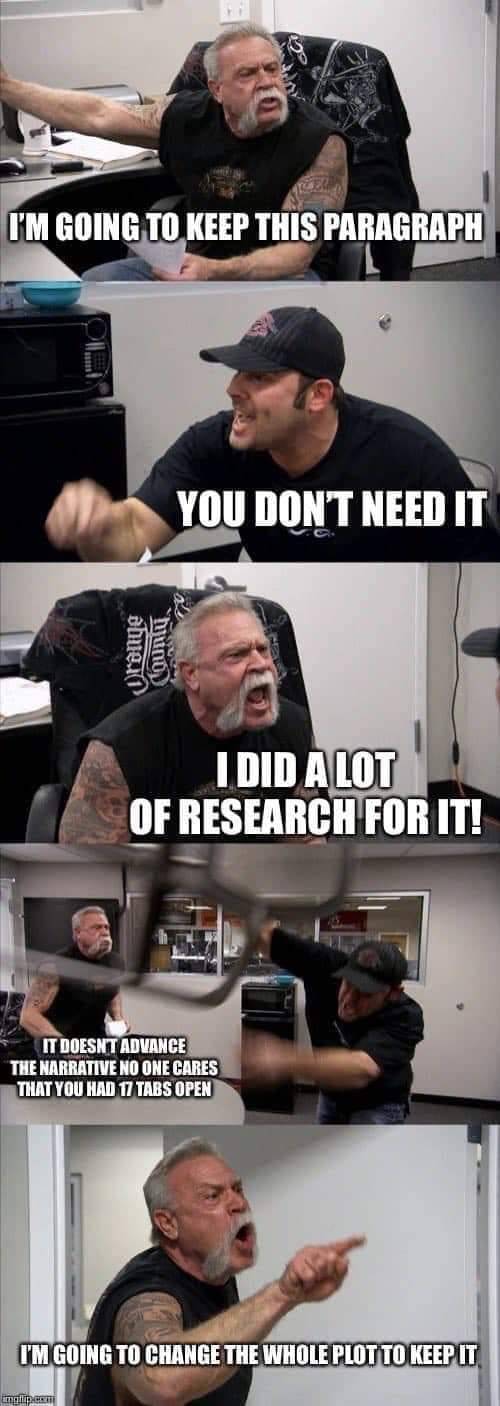Text
I find it personally offensive how many bad writers can get published so easily.
44K notes
·
View notes
Text
90% of writing advice can be thrown out the window for your first draft.
Show don’t tell? Ignore.
Basic grammar and punctuation? Unnecessary.
Physical descriptions of characters? Don’t need to bother.
Solid plot? That’s for later.
The words don’t come as fast when you’re thinking of the best way to put them together. It doesn’t have to be pretty, or much more than inconsistent nonsense. The point is to have it exist.
Effective storytelling is for subsequent drafts! Go write some nonsense!
46K notes
·
View notes
Text
A quick reference for writing characters with glasses when you don’t wear glasses
For Myopia related glasses (aka someone who is nearsighted and can’t see stuff far away) you cannot stop at a drug store to get some new ones
You have not invented glasses that turn dark in the sunlight, those already exist. They’re called transition and it’s kinda pricy
Glasses are very very very expensive and sometimes we can only afford to swap out the lenses and just patch up the frame with some electrical tape
Velma was not exaggerating in scooby do, if your eyesight is bad enough and you drop your glasses, depending on their color and where you drop them it will be hard to find them again if you have bad eyesight. (I have red glasses and a red duvet... the struggle is real)
There are a lot of nervous ticks related to glasses like pushing them up, taking them off to clean them, etc
We’re not supposed to clean our glasses with our t-shirt but most of us do it anyway because it’s easier
Depending on the amount of prescription it is possible to forget to wear your glasses, and very annoying when you realize you have (I speak from experience with my old pair of glasses, I now cannot forget them any longer)
Not wearing glasses causes forced vision which causes headaches which hurt. Not fun.
If you have a big prescription and frames that are too thin, the lenses will pop out and it will be annoying but usually they can be popped back in on their own.
I usually have to take off my glasses to use my phone because I’m near sighted and they don’t let me see properly when I’m using my phone. This also apply when reading a book and sticking it to your face or any paper that you hold closely
This is mostly just a list of thoughts typed out by a everyday glasses user that I find could be handy when writing characters with glasses when you yourself don’t wear them. List was inspired by reading something in a book that did what I said you can’t do in bullet point 1.
Feel free to add on to the list if you’d like
1K notes
·
View notes
Note
So, I don't know how to write pain like! What words do I use? how do I describe it! I really need some help here!
No problem! And sorry about not answering sooner, I was on vacation. To make it up to you, I’ve made one of my trademark Long Posts about it.
TIPS ON HOW TO WRITE PAIN (FOR BOTH ORIGINAL CONTENT WRITERS AND FANFICTION WRITERS)

When I first started writing, about eight years ago, I had the same issue as @imjustafuckinggirl.
How are you supposed to write about pain you’ve never experienced before???
The characters in my book suffer through all sorts of terrible shit, and in no way am I writing from experience, which is marginally easier to do than write about something that has never happened to you.
However, with time, I managed to gather up a few strategies on how to write pain.
1. Don’t Write Paragraphs About It

I know, it’s tempting. You want to convey to the reader just how much pain the character is in, and you think that the pain will be emphasized the more you write about it.
This, however, is a lie.
As a reader, when I’m reading a book or fanfiction where, whenever the writer uses agonizingly long paragraphs to describe when a character is hurt, I skip it.
Entirely.
It’s boring and, quite frankly, unnecessary, especially during a fight or huge battle, which are supposed to be fast-paced.
When it comes to writing about pain, it really is about quality and not quantity.
In my own writing, I stick to short, quick paragraphs, some of them which are barely a line long. This gives it a faster pace and sort of parallels with the scattered, spread out thoughts of the character as they suffer.
2. Describe it Right

Many times, usually in fanfiction, writers over-exaggerate certain injuries.
This partially has to do with the fact that they’ve never experienced that injury before and are just thinking about what it might feel like.
As a girl with two brothers and who often participated in rough play-fights, I can assure you that getting punched is not as painful as you think it is.
(However, it does depend on the area, as well as how hard the punch is, on top of the fact that you have to take into account whether or not the punch broke bones)
I’m reading a high school AU where a character gets punched by a bully (Idk where they got punched it wasn’t stated) and the author is describing it like they’d been shot.
It was to the point where I was like Did the bully have brass knuckles or something????
It was very clear that this author had never been punched before.
When describing the pain of an injury or the injury itself, you have to take into account:
- What object was used to harm the character
- Where the injury is
- How long the character has had the injury
- (For blades) How deep the cut is
- (For blunt force trauma) How hard the hit was
- Whether or not the wound triggers other things (Ex: Concussion, vomiting, dizziness, infection, internal/external bleeding).
There’s also the fact that when some authors described wounds caused by blades such as knives, daggers, and swords, they never take into account the anatomy of a person and which places cause the most blood flow.
Obviously, a cut on your cheek will have less of a blood flow than a cut on your wrist, depending on what the blade hits, and I hope that everyone consults a diagram of veins, capillaries, arteries, etc. when they’re describing blood flow from a certain place.
There’s also the fact that you have to take into account where the blood is coming from. Veins? Arteries?
The blood from arteries will be a brighter red, like vermilion, than the blood from veins, which is the dark crimson everyone likes to talk about.
Not all places gush bright red blood, people!
3. DIFFERENT INJURIES HAVE DIFFERENT KINDS OF PAIN
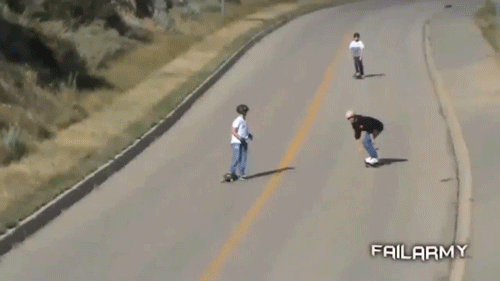
Here, let me explain.
A punch feels different from a slap.
A broken arm feels different from getting stabbed.
A fall feels different from a dog bite.
I’ll give you a list of all the kinds of things that can be described for the three most common kinds of injuries that happen in stories:
Punch/Blunt Force Trauma
How it feels:
- Aching
- Numbness (In the later stages)
- A single spike of pain before it fades into an ache
- Throbbing
Effects:
- Vomiting (If the character is punched in the gut)
- Swelling
- Bruising
- Broken bones
- Unconsciousness (Blow to the head)
- Dizziness (Blow to the head)
- Concussion (Also a blow to the head)
- Internal bleeding
- Death (In the case of concussions and internal bleeding and broken bones- ribs can pierce lungs)
Stab Wound/Cut
How it feels:
- Stinging (only shallow wounds have just stinging)
- Burning
- With stab wounds, I feel like describing the effects of it make it more powerfully felt by the reader
Effects:
- Bleeding (Consult chart of the circulatory system beforehand for the amount of blood flow that should be described and what color the blood should be)
- Dizziness (Heavy blood loss)
- Unconsciousness
- Infection (if left unattended)
- Death
Gunshot
How it feels:
- Depends on the caliber bullet, from how far away they were shot (point-blank range is nothing like being shot from a distance), and in what place. Do careful research and then make your decision.
Effects:
- Bleeding(Consult chart of the circulatory system beforehand for the amount of blood flow that should be described and what color the blood should be. Also take into effect the above variables for blood flow as well.)
- Dizziness (Heavy blood loss)
- Infection (if left unattended)
- Death
Some things that a character may do while they’re injured:
- Heavy/Harsh/Ragged breathing
- Panting
- Making noises of pain
gasping
grunting
hissing
groaning
whimpering
yelping (when the injury is inflicted)
screaming
shrieking
wailing
- Crying/ Weeping/Sobbing/Etc.
- Clenching their teeth
- Unable to speak
- Pressing their hands against a stab wound/cut to try and stem the bleeding
- Eyesight going out of whack (vision blurring and tilting, the room spinning, black spots consuming sight)
- Eyes rolling up into their head
- Trembling/shaking
- Ears riniging (from gunshot)
HOPE THIS HELPED!
49K notes
·
View notes
Text
Reblog this if you're a writeblr and you wouldnt mind:
Random asks about your wips
Being tagged in tag games by people you don't know yet
Strangers complimenting your work
Fellow writeblrs striking up conversations
Interaction with new writeblrs in general
I see so many folks afraid to jump in to the community, so hopefully this post will lay out like a welcome mat for new folks to come say hi :)
4K notes
·
View notes
Text
Character sheet that I like to use with dumb specific questions in the side.
Full name, is one name hidden from friends?
Age group or age specificly, how old are they in the head/mind/in the eyes of others?
Mommy’s boy/girl or daddy’s?
Appearance, how do they like to keep their facial or visible (no clothing) body?
Clothing, what would they love to try to wear for one time only (like someone wanting to try a ridiculous dress or something) and what would they never want to be seen dead in
Political view, how do they affect the political environment in their country/state/etc
Personality, what are the inner battles they go through?
Like, love, dislike and hate, what are some stupid things they like-hate and or stories to why?
Family, is there someone in their family who have dirt on them or other way around?
Friends, witch of the friends would they sacrifice if they couldn’t choose themselves?
Enemies, would they save their enemy from dying?
What is their role in your story? If you where gonna ask them face to face what they want the outcome to be (they knowing you write the story) and then telling them that you are not gonna do that, how would they react?
Backstory, what is the first they remember, and what shaped them the most?
Motivation, when they loose the cause that drives them forward, how do they think of themselves afterwards?
Needs, what do they need in life? If they were to lose that in a way that is unnoticeable, how long would it take them to notice?
“What you do alone, defines who you really are”. What are your characters doing alone? You can add different scenarios.
Are they a neutral evil, lawful good etc?
Job, if the had a normal life, what would the dream job be?
Notes to add a little extra at the end.
0 notes
Text
Character Creation
(Not another form.)
I’ve been running my characters through these questions lately so I thought I might as well share them? They are meant to be a fun but challenging look at how your characters are going to interact with each other and the plot.
The examples and explanations are simplistic versions and some stories (especially complex ones) will create variation on the standard.
MOTIVATION
1. What does your character want?
This is something they think will make their life better. They either start out the story wanting it or decide they want it at the inciting incident. It’s driven by internal desires that are strong enough to force the character to make external choices within alter the plot. Often this want demonstrates a flaw the character will have to overcome by the end of the story. (Ex. Ash wants vengeance for her sister at any cost to herself and others.)
2. What does your character need?
This is what will in actuality make their life better. It should build off or contrast their want in some way. (Ex. Ash needs to let go of her quest for vengeance in order to protect the people she loves and let them protect her in turn.)
3. At what point does your character realize that what they need isn’t what they want, and what drives this understanding?
This should happen near the end of the story, usually at the beginning of the climax.
Bonus: If your character doesn’t chose to go after what they need instead of what they want during the above realization, at what point do they make this choice, and what drives it?
RELATIONSHIPS
(Note this can apply to both romantic and platonic relationships!)
1. What external influences are keeping these characters apart?
These are things within the world, likely out of their control, such as war or social expectations or conflicting goals or a looming knowledge they’ll be separated.
2. What internal beliefs are keeping these characters apart?
This is generally old baggage that comes from a feeling, such as fear of being betrayed or not feeling good enough, but it can also be something that arises as time goes on, such as the fear that being honest about their changing beliefs will cause a rift.
3. What does the character have to lose if the relationship falls apart or doesn’t mature?
This can be anything from not having someone there to share their dreams with to not having the skills the other personal provides their sleuthing partnership.
4. What does the character gain if everything works out and these two people are happy together?
Pretty much the same as question three except, you know, opposite.
PERSONALITY
1. If your character is placed in a bare room with a single closed door and told to pick one of these items, which do they chose: a knife, a shield, or a bandage.
Bonus: Why did they pick that item?
2. If you had to portray this character through one action (not a personality trait or a descriptor but an action) what would they be doing?
This could be a hobby, or nervous habit, a presentation of emotion, etc, but it has to show who the character is.
2K notes
·
View notes
Note
I was wondering if you knew any basic guides to outlining a novel for the first time?
Outlining a story is very, very important. Without an outline and thorough planning, your story will veer off in wildly different directions and will cost you a ton of time editing later, like my book did.
1. Get the characters down first
Characters are like the chess pieces of the story. Their moves and strengths/weaknesses will decide what is going to happen and how it will happen. Sure, you can have a nice plot and setting, but without the characters, the story is meaningless.
Here is the character chart that I usually use:
Name (First/Middle/Last/Maiden name)
Aliases/Nicknames
Age
Race
Gender
Sexuality
Height
Weight
Eye color
Hair color
Clothing style
Religion
Political views
Personality Traits
Strengths and Weaknesses
Likes and Dislikes
Family
Friends
Enemies
Role in the story
Backstory/past
2. Choose a template
Just bulleting the events does not give the plot the dimension that it deserves and does not really accommodate side plots.
I personally use the zigzag method that I discovered from this post. I branch off of the zigzags for my side plots so it looks kind of like a graph.
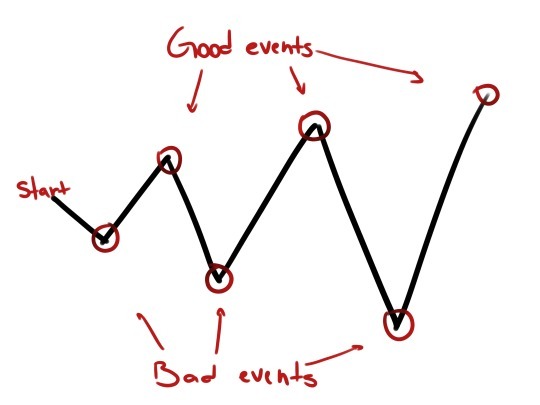
You can also use the subway method, which I found on the nanowrimo website.

There are a whole other host of outlines to choose from if you search them up!
3. Know that you don’t have to stick to it
An outline is just that: an outline. It’s not the final decision for the plot, it’s the first draft for the plot. If you’re writing and one of the points just isn’t working anymore, you don’t have to keep it because it was a part of your outline.
Write what feels right.
Happy outlining, and good luck with your story!
10K notes
·
View notes
Text
100 Sentence Prompts
(thank you too @inqusitor-sane for a few of these)
1. ‘Stop being such a stick in the mud!’
2. ‘Come dance with me.’
3. ‘They are just like you.’
4. ‘Just hold on, you’ll be alright.’
5. ‘I won’t leave you, never.’
6. ‘I’m sorry.’
7. ‘This is so not the time or place for this.’
8. ‘Jackpot!’
9. ‘You’re blushing.’
10. ‘You got something on your face. Let me clean it off.’
11. ‘What did you say?’
12. ‘Before sunrise, they are your child/children’
13. ‘How did we get in this mess?’
14. ‘Are you okay?’
15. ‘Who are you?’
16. ‘What was that?’
17. ‘Will you marry me?’
18. ‘That’s not what I meant!’
19. ‘Liar!’
20. ‘I wish I could stay in this moment forever.’
21. ‘This isn’t like you.’
22. ‘What’s in it for me?’
23. ‘I hate you.’
24. ‘Tickle fight!’
25. ‘You’re my one and only.’
26. ‘It’s been a while.’
27. ‘Let me walk you home.’
28. ‘It’s just you and me tonight. We can do whatever we want.’
29. ‘When was the last time you slept?!?’
30. ‘Make a wish’
31. ‘I’ll never forgive you.’
32. ‘You know me too well.’
33. ‘Just hold my hand.’
34. ‘Wake up, please.’
35. ‘This wasn’t supposed to happen.’
36. ‘I never wanted to hurt you.’
37. ‘What are you hiding?’
38. ‘It’s a beautiful night.’
39. ‘They are so your child/children.’
40. ‘I’ll miss you.’
41. ‘Remember when [event]’
42. ‘It’s so hot out!’
43. ‘But I thought you liked this?’
44. ‘What have you’ve done?”
45. ‘No one can know.’
46. ‘Everything will be okay.’
47. ‘You’re sick.’
48. ‘I’m never letting go.’
49. ‘There is only one bed.’
50. ‘You look lovely today’
51. ‘There is so much blood.’
52. ‘I can’t!’
53. ‘I’m not afraid.’
54. ‘Tell me something I don’t know about you.’
55. ‘Let’s ditch this place and do something fun!’
56. ‘How did you talk me into this?”
57. ‘Today is a new day.’
58. ‘My clothes look good on you.’
59. ‘Where am I?’
60. ‘We are going to have the cutest babies ever!’
61. ‘I think we’re lost.’
62. ‘How did you know?”
63. ‘It’s not what it looks like.’
64. ‘Keep your eyes open.’
65. ‘Do as I do.’
66. ‘You’re cold.’
67. ‘You think it will lighten up soon?’
68. ‘I can’t see anything.’
69. ‘What did I do to get you again?’
70. ‘Look what I found!’
71. ‘Just breath.’
72. ‘Let’s go to bed.’
73. ‘You believe me, right?’
74. ‘Let’s go exploring!’
75. ‘That’s so sweet of you.’
76. ‘I think we’re stuck.’
77. ‘I need to leave.’
78. ‘You look beautiful, no matter what.’
79. ‘Stop!’
80. ‘You’re hurt, let me help.’
81. ‘I dare you!’
82. ‘What happened here?”
83. ‘Just this once.’
84. ‘We should go home.’
85. ‘Let’s go for a swim!’
86. ‘For science!’
87. ‘Move over.’
88. ‘We have to help!’
89. ‘This must be the happiest moment of my life.’
90. ‘It’s just a cut.’
91. ‘I feel stupid.’
92. ‘This is one heck of a storm.’
93. ‘Hit the deck!’
94. ‘A kiss for good luck?’
95. ‘I didn’t know you could sing.’
96. ‘You’re so cute when your sleeping.’
97. ‘I will always protect you.’
98. ‘Forever.’
99. ‘Run!’
100. ‘Sit, relax, I won’t bite.’
3K notes
·
View notes
Text
After writing a total of 682 words on my brand new idea...
I`m gonna reward myself with a six hour break
1 note
·
View note
Photo

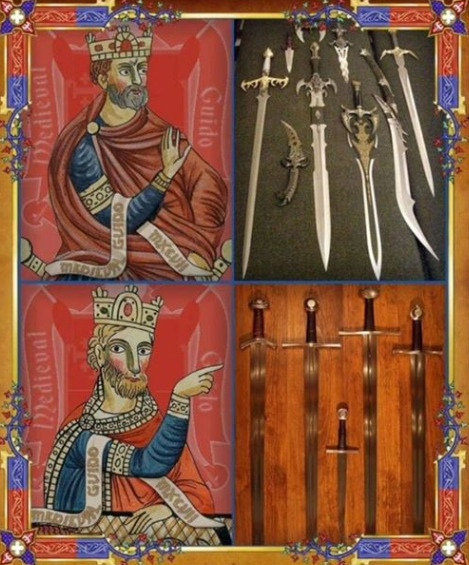
look. look at this beautiful sword meme. i’m going to cry
144K notes
·
View notes
Text
some of the best writing advice I’ve ever received: always put the punch line at the end of the sentence.
it doesn’t have to be a “punch line” as in the end of a joke. It could be the part that punches you in the gut. The most exciting, juicy, shocking info goes at the end of the sentence. Two different examples that show the difference it makes:
doing it wrong:
She saw her brother’s dead body when she caught the smell of something rotting, thought it was coming from the fridge, and followed it into the kitchen.
doing it right:
Catching the smell of something rotten wafting from the kitchen—probably from the fridge, she thought—she followed the smell into the kitchen, and saw her brother’s dead body.
Periods are where you stop to process the sentence. Put the dead body at the start of the sentence and by the time you reach the end of the sentence, you’ve piled a whole kitchen and a weird fridge smell on top of it, and THEN you have to process the body, and it’s buried so much it barely has an impact. Put the dead body at the end, and it’s like an emotional exclamation point. Everything’s normal and then BAM, her brother’s dead.
This rule doesn’t just apply to sentences: structuring lists or paragraphs like this, by putting the important info at the end, increases their punch too. It’s why in tropes like Arson, Murder, and Jaywalking or Bread, Eggs, Milk, Squick, the odd item out comes at the end of the list.
Subverting this rule can also be used to manipulate reader’s emotional reactions or tell them how shocking they SHOULD find a piece of information in the context of a story. For example, a more conventional sentence that follows this rule:
She opened the pantry door, looking for a jar of grape jelly, but the view of the shelves was blocked by a ghost.
Oh! There’s a ghost! That’s shocking! Probably the character in our sentence doesn’t even care about the jelly anymore because the spirit of a dead person has suddenly appeared inside her pantry, and that’s obviously a much higher priority. But, subvert the rule:
She opened the pantry door, found a ghost blocking her view of the shelves, and couldn’t see past it to where the grape jelly was supposed to be.
Because the ghost is in the middle of the sentence, it’s presented like it’s a mere shelf-blocking pest, and thus less important than the REAL goal of this sentence: the grape jelly. The ghost is diminished, and now you get the impression that the character is probably not too surprised by ghosts in her pantry. Maybe it lives there. Maybe she sees a dozen ghosts a day. In any case, it’s not a big deal. Even though both sentences convey the exact same information, they set up the reader to regard the presence of ghosts very differently in this story.
36K notes
·
View notes
Text
My advice when folks are struggling with writing in the third-person omniscient is to Lemony Snicket it up. Give your omniscient narrator strong opinions about what’s going on. Don’t fall into the trap of assuming that the third-person omniscient perspective must also use the objective voice; those are two separate things, and many of the most popular and successful writers who’ve written in the third-person omniscient do not, in fact, use the objective voice.
80K notes
·
View notes
Text
Random mansion generator
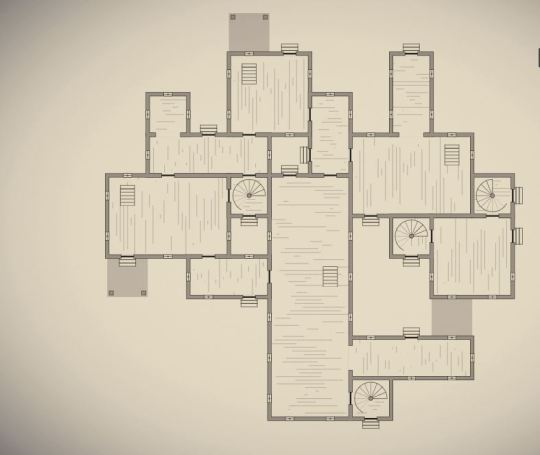

The Procgen Mansion Generator produces large three-dee dwellings to toy with your imagination, offering various architectural styles and other options. Each mansion even comes with floorplans:
https://boingboing.net/2019/07/12/random-mansion-generator.html
231K notes
·
View notes
Text
there’s a quarantine going on… no pressure but i KNOW ya’ll have WIPs
86K notes
·
View notes
Text
Writing Traumatic Injuries References
So, pretty frequently writers screw up when they write about injuries. People are clonked over the head, pass out for hours, and wake up with just a headache… Eragon breaks his wrist and it’s just fine within days… Wounds heal with nary a scar, ever…
I’m aiming to fix that.
Here are over 100 links covering just about every facet of traumatic injuries (physical, psychological, long-term), focusing mainly on burns, concussions, fractures, and lacerations. Now you can beat up your characters properly!
General resources
WebMD
Mayo Clinic first aid
Mayo Clinic diseases
First Aid
PubMed: The source for biomedical literature
Diagrams: Veins (towards heart), arteries (away from heart) bones, nervous system, brain
Burns
General overview: Includes degrees
Burn severity: Including how to estimate body area affected
Burn treatment: 1st, 2nd, and 3rd degrees
Smoke inhalation
Smoke inhalation treatment
Chemical burns
Hot tar burns
Sunburns
Incisions and Lacerations
Essentials of skin laceration repair (including stitching techniques)
When to stitch (Journal article–Doctors apparently usually go by experience on this)
More about when to stitch (Simple guide for moms)
Basic wound treatment
Incision vs. laceration: Most of the time (including in medical literature) they’re used synonymously, but eh.
Types of lacerations: Page has links to some particularly graphic images–beware!
How to stop bleeding: 1, 2, 3
Puncture wounds: Including a bit about what sort of wounds are most likely to become infected
More about puncture wounds
Wound assessment: A huge amount of information, including what the color of the flesh indicates, different kinds of things that ooze from a wound, and so much more.
Home treatment of gunshot wound, also basics
More about gunshot wounds, including medical procedures
Tourniquet use: Controversy around it, latest research
Location pain chart: Originally intended for tattoo pain, but pretty accurate for cuts
General note: Deeper=more serious. Elevate wounded limb so that gravity draws blood towards heart. Scalp wounds also bleed a lot but tend to be superficial. If it’s dirty, risk infection. If it hits the digestive system and you don’t die immediately, infection’ll probably kill you. Don’t forget the possibility of tetanus! If a wound is positioned such that movement would cause the wound to gape open (i.e. horizontally across the knee) it’s harder to keep it closed and may take longer for it to heal.
Broken bones
Types of fractures
Setting a broken bone when no doctor is available
Healing time of common fractures
Broken wrists
Broken ankles/feet
Fractured vertebrae: Neck (1, 2), back
Types of casts
Splints
Fracture complications
Broken noses
Broken digits: Fingers and toes
General notes: If it’s a compound fracture (bone poking through) good luck fixing it on your own. If the bone is in multiple pieces, surgery is necessary to fix it–probably can’t reduce (“set”) it from the outside. Older people heal more slowly. It’s possible for bones to “heal” crooked and cause long-term problems and joint pain. Consider damage to nearby nerves, muscle, and blood vessels.
Concussions
General overview
Types of concussions 1, 2
Concussion complications
Mild Brain Injuries: The next step up from most severe type of concussion, Grade 3
Post-concussion syndrome
Second impact syndrome: When a second blow delivered before recovering from the initial concussion has catastrophic effects. Apparently rare.
Recovering from a concussion
Symptoms: Scroll about halfway down the page for the most severe symptoms
Whiplash
General notes: If you pass out, even for a few seconds, it’s serious. If you have multiple concussions over a lifetime, they will be progressively more serious. Symptoms can linger for a long time.
Character reaction:
Shock (general)
Physical shock: 1, 2
Fight-or-flight response: 1, 2
Long-term emotional trauma: 1 (Includes symptoms), 2
First aid for emotional trauma
Treatment (drugs)
WebMD painkiller guide
Treatment (herbs)
1, 2, 3, 4
Miscellany
Snake bites: No, you don’t suck the venom out or apply tourniquettes
Frostbite
Frostbite treatment
Severe frostbite treatment
When frostbite sets in: A handy chart for how long your characters have outside at various temperatures and wind speeds before they get frostbitten
First aid myths: 1, 2, 3, 4, 5 Includes the ones about buttering burns and putting snow on frostbite.
Poisons: Why inducing vomiting is a bad idea
Poisonous plants
Dislocations: Symptoms 1, 2; treatment. General notes: Repeated dislocations of same joint may lead to permanent tissue damage and may cause or be symptomatic of weakened ligaments. Docs recommend against trying to reduce (put back) dislocated joint on your own, though information about how to do it is easily found online.
Muscular strains
Joint sprain
Resuscitation after near-drowning: 1, 2
Current CPR practices: We don’t do mouth-to-mouth anymore.
The DSM IV, for all your mental illness needs.
Electrical shock
Human response to electrical shock: Includes handy-dandy voltage chart
Length of contact needed at different voltages to cause injury
Evaluation protocol for electric shock injury
Neurological complications
Electrical and lightning injury
Cardiac complications
Delayed effects and a good general summary
Acquired savant syndrome: Brain injuries (including a lightning strike) triggering development of amazing artistic and other abilities
Please don’t repost! Reblogging is fine, of course. You can find the original document (also created by me) here.
EDIT 3/20/19: This post is now approx. five years old. Yes, I am aware some of the links are broken. No, I’m not going to go through and fix them. I have a job now and that job is not “maintain a database of writing resources.” However, you are welcome to make your own post with updated links, or put updated links in your reblogs.
127K notes
·
View notes
